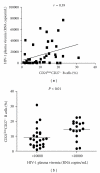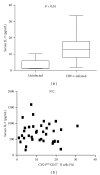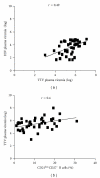Emergence of exhausted B cells in asymptomatic HIV-1-infected patients naïve for HAART is related to reduced immune surveillance
- PMID: 22474482
- PMCID: PMC3303688
- DOI: 10.1155/2012/829584
Emergence of exhausted B cells in asymptomatic HIV-1-infected patients naïve for HAART is related to reduced immune surveillance
Abstract
Alterations of B cell subpopulations have been described up to date as characterizing advanced stage of HIV-1 infection. However, whether such defects are relevant in subjects with a preserved number of CD4⁺ T cells (>350 cells/μL) is unclear. In a cross-sectional study, we investigated if signs of B cells exhaustion and impaired viral immune surveillance are present in a cohort of 43 asymptomatic HIV-1-infected patients with preserved CD4⁺ T cell counts (>350 cells/μL) and highly active antiretroviral therapy (HAART) untreated. A dramatic expansion of exhausted tissue-like memory B cells (CD10⁻CD21(low)CD27⁻) was observed. B cells alteration was related to an increase in Torque teno virus (TTV) load, used as surrogate marker of immune function. Successfully HAART-treated patients showed normalization of B cell subpopulations frequency and TTV load. These results provide new insights on B cell in HIV-1 infection and show that development of B cell abnormalities precedes CD4⁺ T cell decline.
Figures





References
-
- Lane HC, Masur H, Edgar LC, Whalen G, Rook AH, Fauci AS. Abnormalities of B-cell activation and immunoregulation in patients with the acquired immunodeficiency syndrome. New England Journal of Medicine. 1983;309(8):453–458. - PubMed
-
- Amadori A, De Rossi A, Faulkner-Valle GP, Chieco-Bianchi L. Spontaneous in vitro production of virus-specific antibody by lymphocytes from HIV-infected subjects. Clinical Immunology and Immunopathology. 1988;46(3):342–351. - PubMed
-
- Fournier AM, Fondere JM, Alix-Panabieres C, et al. Spontaneous secretion of immunoglobulins and anti-HIV-1 antibodies by in vivo activated B lymphocytes from HIV-1-infected subjects: monocyte and natural killer cell requirement for in vitro terminal differentiation into plasma cells. Clinical Immunology. 2002;103(1):98–109. - PubMed
Publication types
MeSH terms
Substances
LinkOut - more resources
Full Text Sources
Other Literature Sources
Medical
Research Materials

